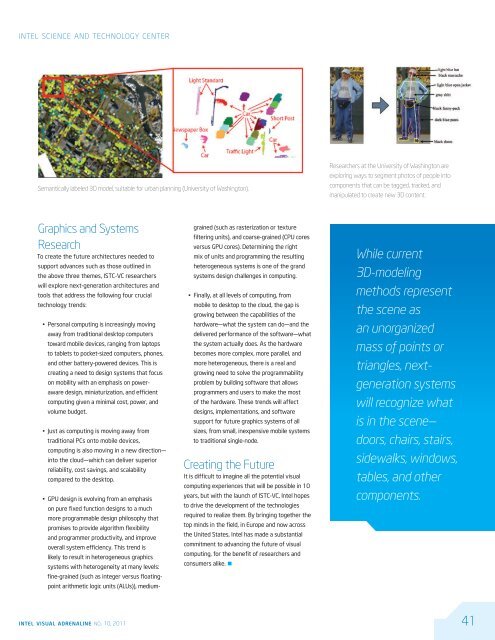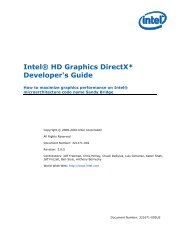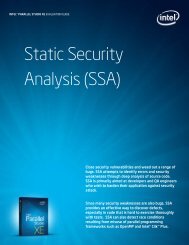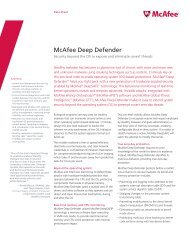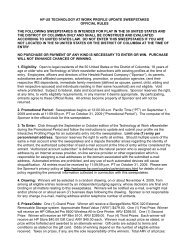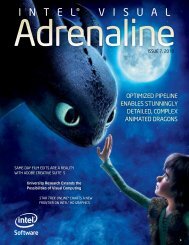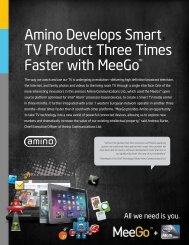Intel ® Visual
Intel ® Visual
Intel ® Visual
You also want an ePaper? Increase the reach of your titles
YUMPU automatically turns print PDFs into web optimized ePapers that Google loves.
intel science and technology center<br />
Semantically labeled 3D model, suitable for urban planning (University of Washington).<br />
Graphics and Systems<br />
Research<br />
To create the future architectures needed to<br />
support advances such as those outlined in<br />
the above three themes, ISTC-VC researchers<br />
will explore next-generation architectures and<br />
tools that address the following four crucial<br />
technology trends:<br />
• Personal computing is increasingly moving<br />
away from traditional desktop computers<br />
toward mobile devices, ranging from laptops<br />
to tablets to pocket-sized computers, phones,<br />
and other battery-powered devices. This is<br />
creating a need to design systems that focus<br />
on mobility with an emphasis on poweraware<br />
design, miniaturization, and efficient<br />
computing given a minimal cost, power, and<br />
volume budget.<br />
• Just as computing is moving away from<br />
traditional PCs onto mobile devices,<br />
computing is also moving in a new direction—<br />
into the cloud—which can deliver superior<br />
reliability, cost savings, and scalability<br />
compared to the desktop.<br />
• GPU design is evolving from an emphasis<br />
on pure fixed function designs to a much<br />
more programmable design philosophy that<br />
promises to provide algorithm flexibility<br />
and programmer productivity, and improve<br />
overall system efficiency. This trend is<br />
likely to result in heterogeneous graphics<br />
systems with heterogeneity at many levels:<br />
fine-grained (such as integer versus floatingpoint<br />
arithmetic logic units (ALUs)), medium-<br />
grained (such as rasterization or texture<br />
filtering units), and coarse-grained (CPU cores<br />
versus GPU cores). Determining the right<br />
mix of units and programming the resulting<br />
heterogeneous systems is one of the grand<br />
systems design challenges in computing.<br />
• Finally, at all levels of computing, from<br />
mobile to desktop to the cloud, the gap is<br />
growing between the capabilities of the<br />
hardware—what the system can do—and the<br />
delivered performance of the software—what<br />
the system actually does. As the hardware<br />
becomes more complex, more parallel, and<br />
more heterogeneous, there is a real and<br />
growing need to solve the programmability<br />
problem by building software that allows<br />
programmers and users to make the most<br />
of the hardware. These trends will affect<br />
designs, implementations, and software<br />
support for future graphics systems of all<br />
sizes, from small, inexpensive mobile systems<br />
to traditional single-node.<br />
Creating the Future<br />
It is difficult to imagine all the potential visual<br />
computing experiences that will be possible in 10<br />
years, but with the launch of ISTC-VC, <strong>Intel</strong> hopes<br />
to drive the development of the technologies<br />
required to realize them. By bringing together the<br />
top minds in the field, in Europe and now across<br />
the United States, <strong>Intel</strong> has made a substantial<br />
commitment to advancing the future of visual<br />
computing, for the benefit of researchers and<br />
consumers alike. •<br />
Researchers at the University of Washington are<br />
exploring ways to segment photos of people into<br />
components that can be tagged, tracked, and<br />
manipulated to create new 3D content.<br />
While current<br />
3D-modeling<br />
methods represent<br />
the scene as<br />
an unorganized<br />
mass of points or<br />
triangles, nextgeneration<br />
systems<br />
will recognize what<br />
is in the scene—<br />
doors, chairs, stairs,<br />
sidewalks, windows,<br />
tables, and other<br />
components.<br />
intel visual adrenaline no. 10, 2011 41


